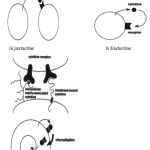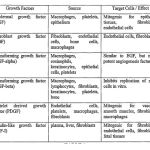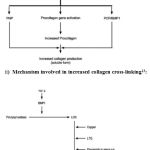Leena Sankari, L. Malathi, M. Kasthuri and N. Balachander
Department of Oral Pathology, Sree Balaji Dental College and Hospital, Bharath University, Pallikaranai, Chennai - 600100.
DOI : https://dx.doi.org/10.13005/bpj/1026
Abstract
Growth factors (GFs) are natural biological mediators that regulate key cellular events that helps in tissue repair and regeneration such as mitogenesis, chemotaxis, differentiation, and metabolism. In recent concepts the areas of cellular and molecular biology explains the functions and their role in repair process. In vivo and vitro studies that proves the GFs can enhance the capacity of tissues to regenerate by regulating cell chemoattraction,differentiation and proliferation. In this review,explains the different role of growth factors in oral tissues and diseases.
Keywords
cell chemoattraction; signaling molecules; chemotaxis
Download this article as:| Copy the following to cite this article: Sankari L, Malathi L, Kasthuri M, Balachander N. Role of Growth Factors in Oral Tissues and Diseases. Biomed Pharmacol J 2016;9(2). |
| Copy the following to cite this URL: Sankari L, Malathi L, Kasthuri M, Balachander N. Role of Growth Factors in Oral Tissues and Diseases. Biomed Pharmacol J 2016;9(2). Available from: http://biomedpharmajournal.org/?p=8092 |
Introduction
Growth factors are signaling molecules utilize their effects on the neighbouring cells or cells located at a distance.These signalling molecules bind and acts on other molecules known as receptor molecules.On the cell surface there are specific growth factor receptor.The binding of growth factor to its growth receptor stimulates cell to grow in a process known as signal transduction1.
Pathway of GF
Growth factor synthesized by an originating cell and bind to its receptor ,activate the target receptor and activates a series of cytoplasmic proteins called signal transducinng proteins and it present on its inner surface of plasma membrane2,3.There are two important proteins ras and ab1 genes.ras binds with guanosine diphosphate (GDP),the cells remain in inactive state.Then the growth factor stimulates the inactive ras becomes active by releasing GDPand it binds to guanosine triphosphate.The active ras inturn activates cytoplasmic kinases and pass signals to nucleus for cell proliferation.
Signaling Molecules
The signals by growth and differentiation factors are transmitted from one cell to another by paracrine, autocrine, juxtacrine, and intracrine modes.
Paracrine
These signals target cells ,which are located in neighbourhood of emitting cell.
Autocrine
Synthesized by one cell, secreted in a soluble form outside the cell and then bind to surface receptors on the same cell to evoke an effect is an autocrine mode of action.
juxtacrine
The adjacent cells should be in cell to cell physical contact.
Endocrine
These signals are called hormones,which travel through the blood to reach a distant place in the body1.
 |
Figure 1: i.Paracrine
ii.Autocrine iii.juxtacrine iv.Endocrine
|
 |
Table 1: Different types of growth factors ,effects and its sources5
|
Role of TGF in Tooth Development
Bell Stage
Histodifferentiation of odontoblasts and ameloblast take place. In addition, the mesenchymal cells differentiate into alveolar bone that forms the sockets for the teeth 10.
↓
Secretion of growth factor by inner enamel epithelial cells
( TGF beta-1,BMP2,IGF)
↓
Bind to heparinsulphate proteoglycan
↓
Ectomesenchymal cells differentiate to odontoblasts
↓
Core binding factor alpha-1 appears in the mesenchyme
( Early bell stage)
↓
Mesenchyme respond to signals from the epithelium
↓
Once the signals reaches cbfa-1 disappears
↓
Odontoblast differentiation start secreting dentin matrix
↓
Gradual disintegration of basement membrane
(MMPs & Proteases)
↓
Preameloblasts interact directly with odontoblasts
↓
Initiation of enamel matrix secretion
Role of TGF-β2 during bell stage
TGF beta -2 shifts to inner enamel epithelial cells
↓
Induces differentiation of odontoblasts
↓
Induces differentiation of ameloblasts
Role of TGF in Oral diseases
Role of TGF-β in cancer
TGF-β exists in three isoforms (TGF-β1, TGF-β2, and TGF-β3), but the extended
superfamily includes more than 30 additional cytokines, classified into several subfamilies
[e.g., bone morphogenetic proteins (BMPs) and activins]. Cancer cells secrete and respond to TGF-β in an autocrine manner11.cytokine induces
↓
cytostatic effect on many epithelial cell types
Receptors
↓
(Heterotetrameric serine/threonine
kinases,)
control proliferation, differentiation, and programmed cell death
Receptors play an important role in apoptosis by signaling through the SMAD pathway
SMAD pathway
TGF-β dimers bind to a type II receptor,
phosphorylation ↓
type I receptor.
↓
Receptor-regulated SMAD (R-SMAD)
Prevents the ability of cells to progress through the cell cycle, and it stimulates apoptosis or differentiation12.
Role of TGF-β in oral submucous fibrosis
collagen synthesis regulated by TGF-β
 |
Figure 2: Mechanism involved in increased collagen cross-linking13
|
Role of TGF-β in periodontal regeneration
Three major activities of TGF-ß include
inhibition of cell proliferation,
enhancement of extracellular matrix deposition and
the exhibition of complex immune regulatory properties.
It can stimulate or inhibit the cell growth ,differentiation and also modulate other GFs like PDGF, EGF and FGF. It inhibits epithelial cell proliferation and stimulates mesenchymal cells. Primarily,it is found in the platelets and osseous tissue.
TGF-β
↓
recruiting and stimulating osteoprogenitor cells
↓
proliferate and desire supporting periodontal wound healing and regeneration2,14.
Conclusion
The present study mainly focus the role of transforming growth factors and other growth factors in odontogenesis,oral cancer,oral submucous fibrosis , periodontium
Reference
- G.P.PAL – Medical genetics,First edition:2009;A.I.T.B.S.Publishers,India.
- Ripamonti U, Herbst NN, Ramoshebi LN. Bone morphogenetic proteins in craniofacial and periodontal tissue engineering: experimental studies in the non-human primate Papio ursinus. Cytokine Growth Factor Rev 2005;16:357-68.
- Anusaksathien O, Giannobile WV. Growth factor delivery to reengineer periodontal tissues. Curr Pharm Biotechnol 2002;3:129-39.
- ZHANGY.D, CHEN Z,SONG Y.Q, Making a tooth: growth factors, transcription factors, and stem cells,Cell Research, 15(5):301-316, May 2005 search by image ,WWW.google.com
- Thesleff I, Nieminen P. Tooth morphogenesis and cell differentiation. Curr Opin Cell Biol 1996; 8:844-50.
- Imai H, Osumi-Yamashita N, Ninomiya Y, Eto K. Contribution of early-emigrating midbrain crest cells to the dental mesenchyme of mandibular molar teeth in rat embryos. Dev Biol 1996; 176: 151-65.
- Zhang YD, Wang SS, Song YQ, et al. Timing of odontogenic neural crest cell migration and tooth-forming capability in mice. Dev Dyn 2000; 226:713-8.
- Thesleff I, Mikkola M. The role of growth factors in tooth development. Int Rev Cytol 2002; 217:93-135.
- Palmer RM, Lumsden AGS. Development of periodontal ligament and alveolar bone in homografted recombinations of enamel organs and papillary, pulpal and follicular mesenchyme in the mouse. Arch Oral Biol 1987; 32:281-9.
- Onichtchouk D, Chen YG, Dosch R, Gawantka V, Delius H, Massague J, Niehrs C. Silencing of TGF-beta signalling by the pseudoreceptor BAMBI. Nature. 1999; 401:480–485. [PubMed:10519551]
- Perlman R, Schiemann WP, Brooks MW, Lodish HF, Weinberg RA. TGF-beta-induced apoptosis is mediated by the adapter protein Daxx that facilitates JNK activation. Nat Cell Biol. 2001; 3:708–714. [PubMed: 11483955]
- Rachana V. Prabhu 1, Vishnudas Prabhu 2, Laxmikanth Chatra; Areca nut in oral submucous fibrosis J Clin Exp Dent. 2014;6(5):e569-75.
- Koo KT, Susin C, Wikesjö UM, Choi SH, Kim CK. Transforming growth factor-beta1 accelerates resorption of a calcium carbonate biomaterial in periodontal defects. J Periodontol 2007;78:723-9.








